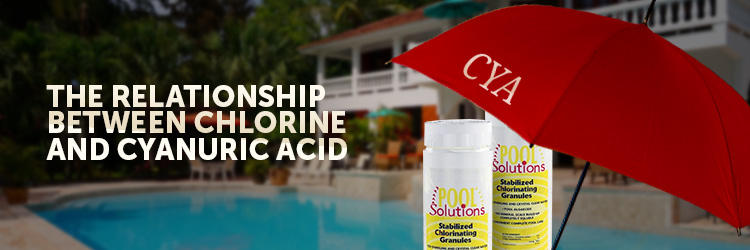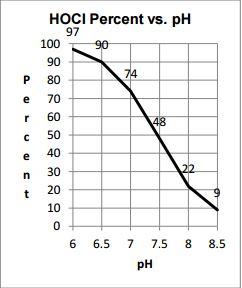We all know that chlorine is necessary to keep our pool sanitized, but do you know the relationship it has with cyanuric acid? Chlorine and cyanuric acid help fight germs, bacteria, and other viruses that may enter our pool at any given time. In fact, chlorine kills bacteria with a 99.9% reduction in less than a minute. Still, there are a ton of questions about chlorine that pool owners still grapple with. Is there such a thing as having too much chlorine? At what point does your pool water become unsafe to swim in due to over-chlorination? How much chlorine do I add to my pool? Is it also true that chlorine is a carcinogen? These questions have multi-faceted answers, so let’s dive right in.
Free Chlorine, Combined Chlorine, and Total Chlorine
First, let’s make sure you understand the differences between free chlorine, combined chlorine, and total chlorine and how you measure each.
Free chlorine (FC) shows the level of disinfecting chlorine available to sanitize your pool. FC is the part of the chlorinated water that hasn’t interacted with contaminants, yet.
Once chlorine interacts with compounds such as urine, sweat, bacteria, etc they form chloramines. Chloramines are what we refer to as combined chlorine (CC). The CC levels are chlorine that no longer has disinfecting power. Essentially, it is useless.
Total chlorine (TC) is simply your FC plus your CC. Your TC should not be less than the FC level.
The Chlorine and Cyanuric Acid Relationship
Though the relationship between chlorine and cyanuric acid is not a new revelation to the pool industry, it is very rare that you come across pool technicians who truly understand the effect one has on the other.
Before you can recognize when you have too much chlorine in your pool, or not enough, you have to know the recommended levels your pool needs. And you won’t be able to understand the recommended levels until you understand the relationship chlorine has with cyanuric acid (CYA) and pH.
You might have read somewhere that the amount of chlorine you need to add to your pool depends on your current CYA levels . Remember, FC not only gets depleted through interacting with germs and bacteria but is also consumed by sunlight. It has been stated that 90% of unprotected chlorine is lost within two hours by direct exposure to sunlight. In a sense, CYA acts as a reservoir for FC. So, if you live in a state like we do (Florida), it’s something you have to consider.
It is essential to maintain the FC/CYA ratio to kill algae and bacteria effectively. It’s been proven that by keeping the correct CYA/FC ratio, you can control algae growth under all conditions. Given a minimum FC concentration, the FC/CYA ratio determines algal growth rates. It is recommended that your FC is 7.5% of your CYA levels. This ratio determines the active chlorine levels needed to prevent algal growth, not just FC alone.
For example, if your pool started with 30 ppm of CYA, then 7.5% of 30 ppm is 2.25pm of FC. As your CYA increases, higher levels of FC are needed in order to prevent algal growth. Below is a chart we pulled from TroublefreePool.Com showing the recommended relation for outdoor residential pools.
Now that we know how CYA affects chlorine, let’s add pH to the mix.
Adding pH to the Mix
In relation to chlorine, the pH of your pool water determines how effective your chlorine is. Higher levels of pH threaten the disinfecting power of chlorine.
To the left is a chart showing the effectiveness of chlorine in relation to pH values when your CYA is zero. You can see that without CYA in your pool and high pH levels, your chlorine becomes ineffective extremely fast. At that point, it doesn’t matter how much FC is available because it’s probably not doing the job.
The pH scale ranges from 0-14, where 7 is considered neutral. Ideally, it is recommended to keep your pH around 7.4, the same as the pH in the human eye. This also gives chlorine good disinfecting power.
Common Chlorine Myths
After helping pool owners for a few years, you realize that there is a ton of bad information on the Internet . Not just bad information, but completely incorrect information. So here are a few myths about chlorine that you may or may not know.
You can smell when there’s too much chlorine in the pool
False. If your pool guy tells you this, politely take a step back, and go in the opposite direction. A properly sanitized pool will not have a strong chemical smell. The strong smell common to many pools, especially public pools, is chloramines. Chloramines are what’s left once chlorine interacts with all the contaminants (i.e. germs, bacteria, soap, dirt, etc.) in the pool. In reality, the chemical smell you think is chlorine is not an indication of a clean pool, but rather a sign that you may need to check your chlorine levels. At this point, the chlorine is working overtime to eliminate all the contaminants in the pool and chlorine may need to be added.
Too much chlorine in the pool stings your eyes.
It’s actually just the opposite. Your eyes are stinging because there’s probably not enough chlorine in your pool. According to the CDC, “Chloramines in the water, like dichloramine and trichloramine, irritate skin, eyes, and the respiratory tract…” As mentioned earlier, chloramines are the byproducts formed when chlorine interacts with all the nasties in your pool water. For red, stinging eyes, the culprit is typically urine. Urine binds with chlorine to form a specific chloramine, which in turn, causes your eyes to sting and turn red. To be specific, it’s not the actual urine, it is the ammonium found in urine. So, the next time someone complains that his/her eyes are red or stinging, you will know it’s because someone peed in the pool.
Too much chlorine caused my daughter’s hair to turn green.
This is another widely spread, misconceived notion pool owners have. Chlorine does not directly turn your hair green nor is chlorine green itself. This happens when there are large compounds of metals, predominantly copper, in the water. The copper interacts with the chlorine in the water to form a compound that binds to your hair. The cuticle, which is the outer covering of your hair, breaks down after it is exposed to high levels of copper. Once in your hair, it oxidizes and turns green. (Think of the color of the Statue of Liberty.)
Although chlorine does not cause your hair to turn green, it is the chlorine that caused the copper to stick to your hair.
Chlorine is considered a carcinogen.
Despite numerous websites, web doctors, and self-proclaimed scientists, there is no current evidence that proves drinking and swimming in water with chlorine causes cancer. So, stop reading the comments section in these articles. Yes, chlorine and chlorine emissions can aggravate respiratory conditions and other health complications, however, there is still no foundation or study that links cancer to chlorine.














Leave a Reply